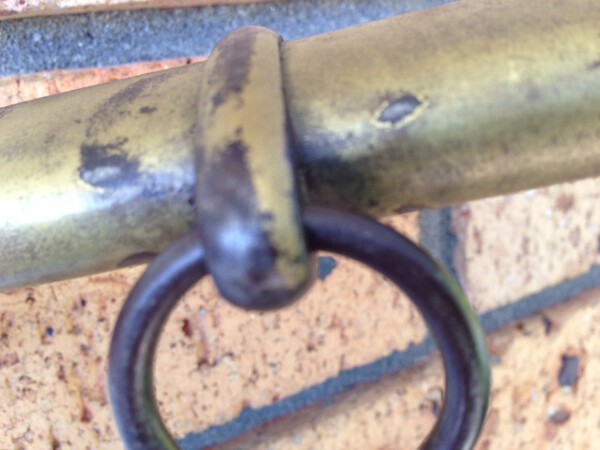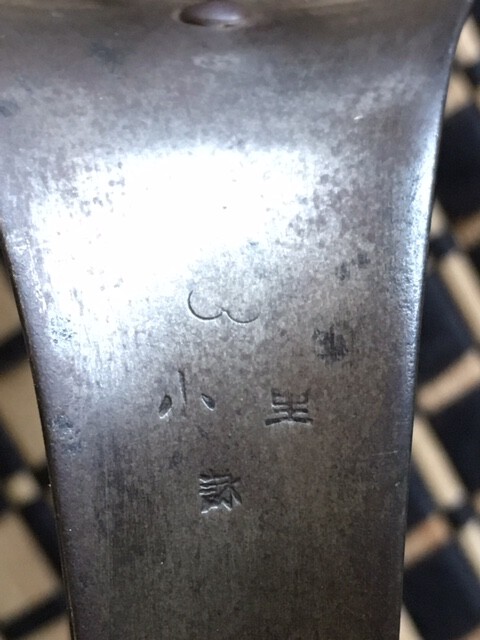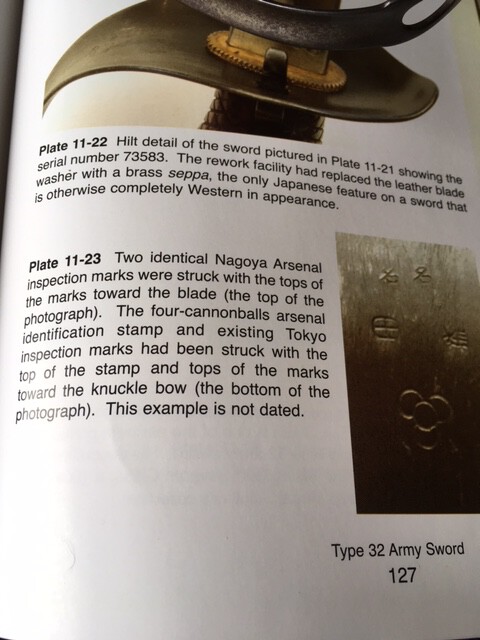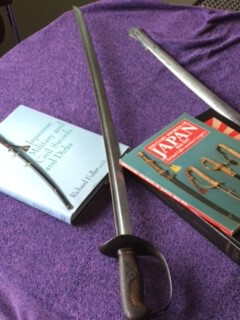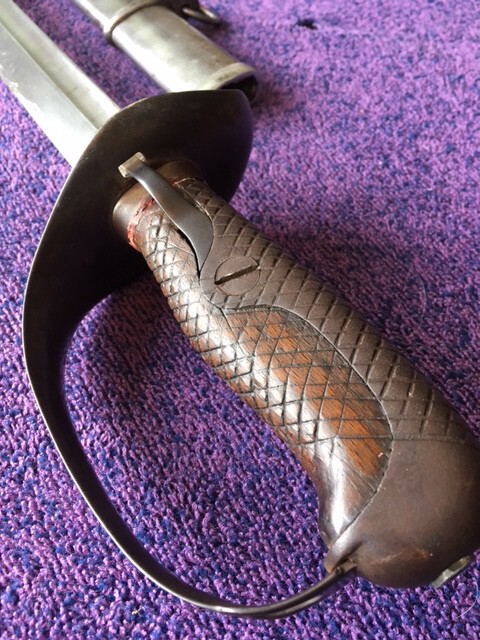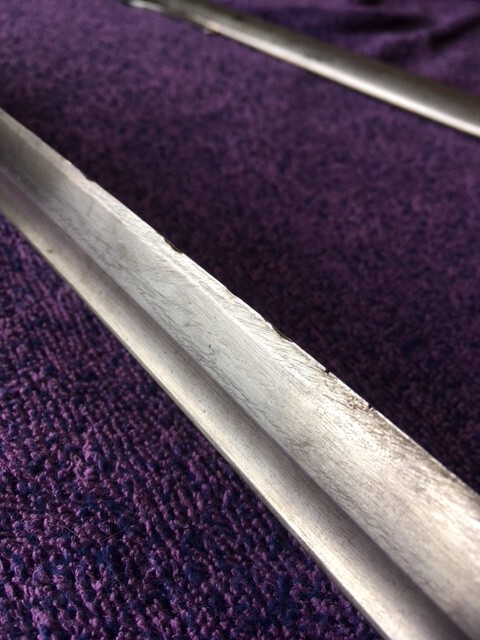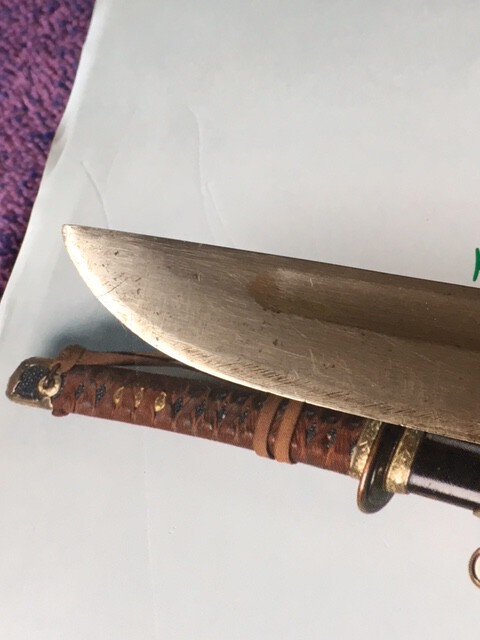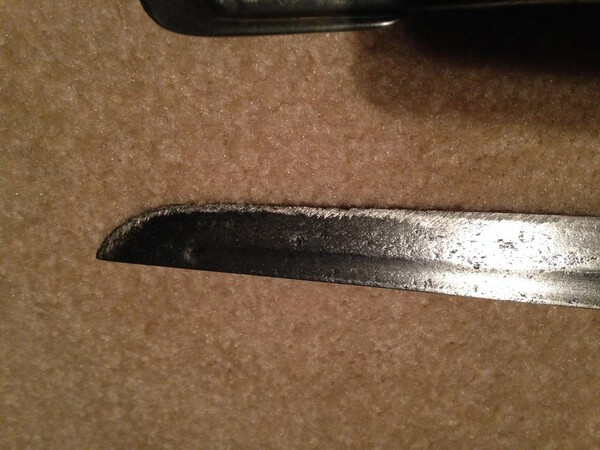-
Posts
12,871 -
Joined
-
Last visited
-
Days Won
154
Everything posted by Bruce Pennington
-

Any Tips For Period Re-Paint?
Bruce Pennington replied to Bruce Pennington's topic in Military Swords of Japan
A recent update on the gold painted gunto. Our good freind IJASWORDS sent me these pics of the saya of a copper handled Type 95. He's a metals guy and analyzed the gold and found it was gold-gilding. By the wear patterns it seems to have been there from the war. Quite a mystery! I've added it to my growing discussion of gold painted gunto on SFI: http://www.swordforum.com/forums/showthread.php?115526-Gold-Painted-Shin-Guntos!&p=1226353#post1226353 -

My First Model 32 Otsu
Bruce Pennington replied to Bruce Pennington's topic in Military Swords of Japan
Yes I was very pleased to see the overall condition and tip considering it was in service for 45 years, probably at least 2 wars. I like the heft of the blade. Very solid, a true weapon. -
Unusual markings on a Muto Mitsuhiro in Naval fittings:http://www.militaria.co.za/nmb/topic/22142-muto-mitsuhiro-in-naval-mounts/
-

Muto Mitsuhiro In Naval Mounts
Bruce Pennington replied to reeder's topic in Military Swords of Japan
Yes, very nice! Quite unusual markings on the nakago mune. I'll add them to thread about mune marks on the "Translations" forum. -

Need Help - Nco Gunto
Bruce Pennington replied to Christopher Miller's topic in Military Swords of Japan
Christopher, When holding the sword with blade down, the right stamp is the stacked cannonballs of the Kokura Army Arsensal. The sword was made by a private contractor represented by the stamp on the left. Some guys call is the "Ichi" stamp, for the single horizontal line in the flower, which is "1" or "Ichi." But the contractors name is a mystery as no experts know who it was. The small middle stamp is the Tokyo Inspector stamp. It's hard to tell the mamufacture dates on Type 95 NCO gunto because blocks of serial numbers were divided up between arsenals and contractors. You'll find some excellent reading and pictures on the Ohmura site: http://ohmura-study.net/957.html. He calls the gunto with the black plate handguard "middle type" which COULD mean they were manufactured in the middle years of the war, but I have seen plenty examples of this type coming EARLIER in numberical sequence than some scuplted handgaurd versions. The handle is removable, but you won't find anything interesting on the tang of Type 95s. At best there are sometimes a "W" stamp which we believe was an inspector stamp. Welcome to collecting! -

My First Model 32 Otsu
Bruce Pennington replied to Bruce Pennington's topic in Military Swords of Japan
Shot of the stamps. Dawson says the stamps, other than the Tokyo Artillery Arsenal, are instpector stamps. Some come with date stamps there, but this one didn't. One of mine is identical to one of these in Daswon. -
Bought on an impulse. Good thing I didn't take a closer look at the saya, or I probably wouldn't have bought it, but I'm glad I did! SERIAL# 5814! Dawson says the range is from 1,xxx to 130,xxx. If these started production in 1899, then this came out in the second year or so. Dawson also says low number gunto are very rare, so guess I stumbled into a rare one. Just a shame the saya is wrong. Look through Dawson, my guess is the saya from a Model 19, though I couldn't find examples of one with the koiguchi screw holes offset like this one. It's a couple inches short for the blade and someone had actually split the end enough for the tip of the blade to stick through enough for the handle to bottom out on the koiguchi. At first I thought it had been cut open, but a closeup of the area shows tearing of the metal. So I don't know what to think about that. Blade is nice, with several edge-dings. Shows the same rough sharpening marks I've been seeing on almost all Model 32s. The end retention nut had been replaced with a standard nut. The patina on the outside of the nut seems to be inline with the rest of the handle, so it may have been done in the field.
-
Nice work, Steve! Too bad about the paint. Leaded paint wasn't outlawed in the US until 1978.
-
After thinking on Dave's idea at the top, it dawned on me that one of the primary things that freaks us out is the high-quality tsuka/tsuba settings fix themselves in our minds as "primary" and then seeing the "NCO" saya, or as Steve expertly has claritfied, a parade/dress saya - seems out of place. But I think that Dave had it right. The gunto was probably originally a parade/dress sabre. It is possible it was damaged in the field, and a repair team, out of the right kink of handle, reworked the nakago and retro-fitted it with nice shingunto befitting a 'dress blade." Just thinking.
-
My thoughts about the paint are: I own 3 very nice Type 95s that came to me with post-war paint. One had been totally stripped and repainted with gold, even the blade!!! The Late war one had gold painted saya and tsuka. The Nagoya side-latch had a horrible blotched multi-green saya. All of which were done by American Gonzo's "fixing up" their swords. No illicit swordmaker would EVER have painted their immitations as horribly as these! So the after-war painting lends credance to the LEGITIMACY of the swords. Maybe new pics will reveal that this paint really isn't gold, I've seen camera auto-corrections change the color of my own shots sometimes. But if it comes out GOLD, I propose it is post-war and, while doesn't prove the legitimacy of the gunto, it certainly isn't a sign of attempted fakery. Whoever went to the trouble to using high quility fittings clearly wouldn't have pulled a Gonzo stunt and paint it gold.
-
Thanks for the clarifications Steve! It's almost impossible to tell proportionality in a pic! And I have seen parade saya with that fat-drag look. I've seen a few habaki with the strange IIIIX markings and have one on a nice kaigunto myself. Seems to speek "custom" to me. VERY interesting piece buddy-boy!
-
Steve, If this post were brought by a stranger everyone would be yelling "Frankenstein!!!!" Buy you have been at this much longer than I and have the balde in hand, which by itself can tell a person a lot, so for the first time, one of our odd-balls is getting a serious look! First, The paint job is gold, not green, sorry dude! Since I've been collecting, I've seen 8 others painted that way, and own 2 of them. I can't clearly see the underlying color in your shots, but it looks red from the ones you've given us. The nakago is so bad, it would normally be an immediate: fake or made in Occupied Islands. But Occupied Island blade makers don't mount with legit IJA parts (very good ones at that), and neither do the fakers. The aluminum seppa were widely used, so no worries there. The saya seems to be a Nagoya NCO, but as you know, they have a screw hole centered on the side, where this one seems to have been made with this offset setting for a nicely made custom throat-cover. My first thought was "No officer would have a custom gunto made with an NCO saya." But we know that due to shortages, early on, officer were carrying Type95s, so why NOT one with an NCO saya? Someone else will have to chime in on the liner writing. The first character looks like the number 8. I have seen a similiar gunto discussed earlier, I wish I could remember when or where, and wonder if it was this same gunto. Everyone was just as stymied on that one too. It's too well put together with good quality fittings to be a fake. Your theory is just as good as any other. Enjoy! And thanks for the challenging discussion!
-

High Quality Type 3 Gunto
Bruce Pennington replied to Bruce Pennington's topic in Military Swords of Japan
Steve, it's there in the second line of my first post, but thanks dude! -

High Quality Type 3 Gunto
Bruce Pennington replied to Bruce Pennington's topic in Military Swords of Japan
Have to share this insight from Nick Komiya on Warrelics: "That is a question similar to asking "why would a rich guy rather buy a spartan sports car than a luxury sedan". The newspapers introducing the sword talked about the sword strictly meaning business and named features like the Kansuke Yamamoto style Tsukamaki for a real fighting man. If one's life may once have to depend on it, many might be made to feel that he would rather have a real fighting sword than the bells and whistles. A name like Kansuke Yamamoto's can go a long way, like a Colt Single Action Army sold as a Wyatt Earp Special. That's marketing and here's Kansuke." -

High Quality Type 3 Gunto
Bruce Pennington replied to Bruce Pennington's topic in Military Swords of Japan
Maybe the "durability" of the 3 attracted guys with money to spend and were willing to upgrade the fittings. I think by "decent" we have differing tastes, though. Mine is the metal saya with a shingunto by Sukekuni. It's a pretty blade. It's dated 1945, so mabye the beauty of many Type 3s hinge on not seeing as much time in the feild? -
All, After seeing a couple of very high quality Type 3 gunto, including the koshirae, I got to re-reading Nick Komiya & Chris Bowen's dicussion of the origins of the Type 3 (http://www.warrelics.eu/forum/Japanese-militaria/deflating-another-myth-type-3-army-officer-s-sword-expanded-version-584796/). The predominent thought is that it was designed as a more durable (koshirae) gunto that was also cheaper than the average standard Type 94/98. But almost every one I've seen have really good looking blades (mine included) and a couple of them now, (one owned by IJASWORDS) have REALLY high quality upgrades to the koshirae. Any thoughts about WHY the Type 3s have such nice blades if they were originally designed to be cheap?
-

Seki Stamp: Only Manufactured Blades?
Bruce Pennington replied to barnejp's topic in Military Swords of Japan
Greg, The answer is "yes." Ha! What the Seki stamp tells you is that the blade is "non-traditional." I've learned to never say never or always, but mostly, the stamp is found on blades made in such a manner that they are not considered traditionally made. The blade could be hand made, in the traditional fashion, but if the smith used non-Japanese steel, then it's classified as non-traditional. If the smith used hydraulic hammers to pound out the steel, it's non-traditional. There are 9 variations and all but 1 are classified as non-traditional. -

Is This A Chimata Stamp On The Nakago?
Bruce Pennington replied to barnejp's topic in Military Swords of Japan
Greg, That's a "Gi" of Gifu stamp. Gifu was a large region the Seki was in. According to Fuller & Gregory, he hasn't seen a Gifu stamp prior to 1943. As your's is undated, I'd use that as the earliest date, unless you find out something else. I wasn't unusual for blades to go unsigned.- 1 reply
-
- 1
-

-
Dave, Unusual paint scheme, for sure! I've seen them with the black, and I believe I've seen a couple of Stegel's examples that were red, but I can't say I've ever seen one with both! (everytime I say something like that, Stegel comes in with an actual example! Ha!) I see 2 things that COULD indicate it was post war: 1) A section of the red paint seems to be lifting off on one of the ito folds, and 2) red paint on the cherry blossom - with all the color variations I've seen, the blossom (when the paint was still there) was gold. My very thin opinion is that the black is original and the red was added.
-
-
Brad, Nice pair! I've had a Ko for some time and am finally getting around to bidding on an Otsu, hope I get it! Mine as the leather finger loop. I initially didin't want it because the blade has lots of corrosion, but the loops get so fragile that they break off, and this one was intact, so I got it. I'm a little puzzled by the fact that both yours and mine have the same really bad sharpening marks (I assumed some bozo in the US used a grinder on min). After seeing yours, it seems too coincidental that they are the same marks. SPECULATION ALERT: I wonder if this might indicate poor sharpening attempts in the field??? or it just means there were more than 1 US Bozo after the war with grinders?!
-

Please Help Me With Tang Translation
Bruce Pennington replied to drb 1643's topic in Military Swords of Japan
Dang! Highest quality Type 3 fittings I've ever seen! What a great find! Hope your seller didn't know what he had! -
Well, Greg, ALL gunto have value!!! With a Seki stamp, it going to be non-traditionally made, so the value will depend upon condition of blade and fittings; then of course, who's buying. Going USA price for a nice one is $1,200 + or -.
-

Please Help Me With Tang Translation
Bruce Pennington replied to drb 1643's topic in Military Swords of Japan
Yes, 1944, easy mistake! The tiny stamp above the date is the "Na" of the Nagoya Arsenal. The star stamp "normally" represents a traditionally made blade, but MUCH debate on that. The addition of the arsenal stamp "could" indicate that it is not Japanese tamahagane steel, therefore not traditionally classed. The kanji writing style is high quality, so it would be nice to see pics of the rest of the blade and blade tip. -

Damascus Blade Auctioning As Japanese
Bruce Pennington replied to Bruce Pennington's topic in Military Swords of Japan
I haven't talked with the Proxibid folks yet on the phone, but I do know that they are just the auction house for other businesses that have large estates they are selling. I suspect that Proxibid just uses the descriptions provided by the sellers. I'll call them next week and ask about that.


